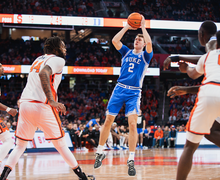Sofia Coppola’s ‘Priscilla’ offers the untold story of Priscilla Presley
Xanthe Kakaras | Contributing Illustrator
With dramatic casting, Sofia Coppola emphasizes the physical difference and age gap between Priscilla and Elvis Presley. The film focuses on the troubled dynamics of their relationship.
Get the latest Syracuse news delivered right to your inbox.
Subscribe to our newsletter here.
With “Priscilla,” director Sofia Coppola tells the story of Elvis and Priscilla Presley’s marriage from a new, female perspective. By depicting her life before she met the superstar and many of their moments out of the public eye, Coppola sheds light on what was going on behind the scenes between Priscilla and “The King.”
“Priscilla” is Coppola’s ninth film, and was released on Oct. 27. The film tells the story of Elvis’ (Jacob Elordi) highly publicized relationship with Priscilla (Cailee Spaeny). Based on Priscilla’s 1985 memoir “Elvis and Me” by Priscilla and Sandra Harmon, Coppola brings the relationship to life on the screen and highlights its problematic dynamics.
From the start of the film, the audience sympathizes with Priscilla. Coppola characterizes Priscilla as an innocent young girl subject to her parents’ wishes by focusing on her family dynamics at her father’s military post in Germany, where she is captivated by Elvis.
At the base, Coppola demonstrates Priscilla’s loneliness through wide shots that make her seem small in comparison to other characters and her surroundings. By showing her as a lonely young girl with no one to turn to, Coppola frames Elvis as a man taking advantage of an easy situation with a girl infatuated with him.
Coppola draws the audience’s attention to Priscilla’s young age and uncomfortably presses this point in her interactions with Elvis. When they meet, 24-year-old Elvis refers to her as “just a baby” after learning her age (14) before kissing her a few scenes later.
Along with this unpleasant dialogue, Coppola’s character blocking demonstrates the dramatic height difference between Elordi and Spaeny to its fullest extent. The casting of Elordi and Spaeny places the age and power dynamics at the forefront of the film, even when it is not displayed outright.
Coppola lets history speak for itself through visual storytelling, as the audience watches Elvis’ physical appearance deteriorate while Priscilla looks more and more doll-like. Priscilla goes through a complete transformation throughout the film, starting as a young girl with hair kept properly to the side before turning into her iconic look with bold, flashy outfits and big, trendy updos.

Fernanda Kligerman | Design Editor
Spaeny plays the part with elegance, subtlety and a demure quality that makes Priscilla feel mature and strong despite the age gap. Using micro-expressions and dynamic body language, Spaeny heartbreakingly depicts a young woman trapped in a tragic relationship.
Her physical transformation is both explicit and subtle, as there are moments where Elvis directly tells her not to wear something, but also moments where the viewer watches Priscilla become more defeated. He directly commands her to change her hair color and her makeup becomes darker and more aggressive as the film continues.
The progression of Priscilla’s outfits pointedly demonstrates Elvis’ increasing control over her through her appearance, but Coppola does not stop there. In one scene, Elvis explicitly tells Priscilla not to work at a boutique so she can be there to answer calls from him 24/7. In another scene, he rudely insults a dress she purchased.
Coppola puts the audience in Priscilla’s corner from the very start, but without dehumanizing Elvis. She demonstrates his good side along with his bad, and sees his low points along with his successes. His abuse begins slowly, with curt comments about her appearance, and eventually escalates to the point of physical violence.
By avoiding shallow, one-sided characterization, Coppola allows “Priscilla” to be a heartbreaking true story. Seen alongside last year’s “Elvis” biopic, it tells a very unique and necessary female-led side of the story.
Beyond the characters themselves, Coppola paints a beautiful picture of the 1960s. She focuses on small details with close-ups of bedside tables, jewelry and nail polish. She shows tabloids from the time period to tell the story of Elvis’ affairs and his growing fame, reminding the audience what era they are in while furthering the plot.
Coppola continues her close-up shots in Elvis’ house, but they eventually devolve into shots of cigarettes and pill bottles as their relationship disintegrates. The shots emphasize the extravagance of Elvis’s house, and many shots place Priscilla’s small stature at odds with the large estate, visually demonstrating her discomfort.
Released in the wake of “Barbie” and other recent films with improved (but still flawed) female representation, Coppola’s film came out at the perfect time. It contributes to a shifting movie culture, refuting Hollywood’s long-standing tradition of not amplifying female directors and actors.
However, the film adds to this development in a more serious style than other hits that premiered this year, serving as a necessary reminder that fans and audiences have no idea what is happening behind the scenes. “Priscilla” highlights female voices in the industry that deserve to be heard.
Published on November 7, 2023 at 10:43 pm






